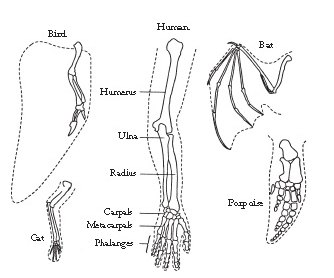Evidence for Evolution
In his book, Darwin offered several pieces of evidence that supported evolution.
He attempted to convince the scientific community of the validity of his theory.
Paleontology
One piece of evidence offered by Darwin is found in the science of paleontology.
Paleontology deals with locating, cataloging, and interpreting the life forms that existed in past millennia.
It is the study of fossils—the bones, shells, teeth, and other remains of organisms, or evidence of ancient organisms, that have survived over eons of time.
Paleontology supports the theory of evolution because it shows a descent of modern organisms from common ancestors.
Paleontology indicates that fewer kinds of organisms existed in past eras, and the organisms were probably less complex.
As paleontologists descend deeper and deeper into layers of rock, the variety and complexity of fossils decrease.
The fossils from the uppermost rock layers are most like current forms.
Fossils from the deeper layers are the ancestors of modern forms.
Comparative anatomy
More evidence for evolution is offered by comparative anatomy (see Figure 12-1).
As Darwin pointed out, the forelimbs of such animals as humans, porpoises, bats, and other creatures are strikingly similar, even though the forelimbs are used for different purposes (that is, lifting, swimming, and flying, respectively).
Darwin proposed that similar forelimbs have similar origins, and he used this evidence to point to a common ancestor for modern forms.
He suggested that various modifications are nothing more than adaptations to the special needs of modern organisms.

The Figure above Shows.The forelimbs of a human and four animals showing the similarity in construction. This similarity was offered by Darwin as evidence that evolution has occurred.
Darwin also observed that animals have structures they do not use.
Often these structures degenerate and become undersized compared with similar organs in other organisms.
The useless organs or body parts are called vestigial organs.
In humans, they include the appendix, the fused tail vertebrae, the wisdom teeth, and muscles that move the ears and nose.
Darwin maintained that vestigial organs may represent structures that have not quite disappeared.
Perhaps an environmental change made the organ unnecessary for survival, and the organ gradually became nonfunctional and reduced in size.
For example, the appendix in human ancestors may have been an organ for digesting certain foods, and the coccyx at the tip of the vertebral column may be the remnants of a tail possessed by an ancient ancestor.
Embryology
Darwin noted the striking similarity among embryos of complex animals such as humans, chickens, frogs, reptiles, and fish.
He wrote that the uniformity is evidence for evolution.
He pointed out that human embryos pass through a
These mechanisms are modified in a way that is unique to an organism’s way of life.
The similarities in comparative embryology are also evident in the early stages of development.
For example, fish, bird, rabbit, and human embryos are similar in appearance in the early stages.
They all have gill slits, a two-chambered heart, and a tail with muscles to move it.
Later on, as the embryos grow and develop, they become less and less similar.
The branch of biology that focuses on embryos and their development is called embryology.
Comparative biochemistry
Although the biochemistry of organisms was not well known in Darwin’s time, modern biochemistry indicates there is a biochemical similarity in all living things.
This comparison of biochemical processes with ancient species is called comparative biochemistry.
For example, the same mechanisms for trapping and transforming energy and for building proteins from amino acids are nearly identical in almost all living systems.
DNA and RNA are the mechanisms for inheritance and gene activity in all living organisms.
The structure of the genetic code is almost identical in all living things.
This uniformity in biochemical organization underlies the diversity of living things and points to evolutionary relationships.
Domestic breeding
From observing the domestic breeding experiments of animal and plant scientists, Darwin developed an idea about how evolution takes place.
Domestic breeding brings about new forms that differ from ancestral stock.
For example, pigeon fanciers have developed many varieties of pigeons through domestic breeding experiments.
In effect, evolution has taken place under the guidance of human hands.
The development of new agricultural crops by farmers and botanists provides more evidence for directed evolution.
Geographic distribution
Darwin was particularly interested in the life forms of the Galapagos Islands.
He noticed how many of the birds and other animals on the islands were found only there.
The finches were particularly puzzling; Darwin found 13 species of finches not found anywhere else in the world, as far as he knew.
He concluded that the finches had evolved from a common ancestral group that probably reached the island many generations earlier.
In the isolation of the Galapagos Islands, the original finches had probably evolved into the 13 species.
The geographic distribution of species in geographic areas can help to explain evolution.
For instance, alligators are located only in certain regions of the world, presumably because they have evolved in those regions.
The islands of Australia and New Zealand have populations of animals found nowhere else in the world because of their isolated environments.
Scholarship 2025/26
Current Scholarships 2025/2026 - Fully Funded
Full Undergraduate Scholarships 2025 - 2026
Fully Funded Masters Scholarships 2025 - 26
PhD Scholarships for International Students - Fully Funded!
Funding Opportunities for Journalists 2025/2026
Funding for Entrepreneurs 2025/2026
***
